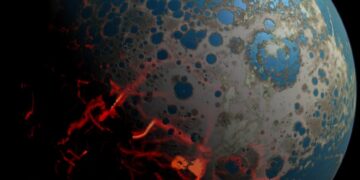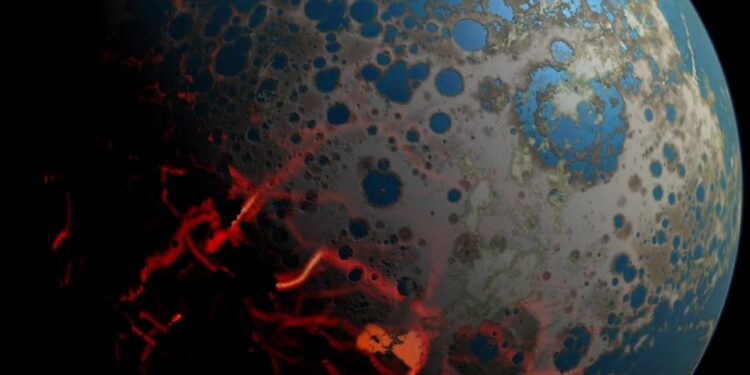Could Cosmic Dust Be the Missing Ingredient for Life on Earth? New Study Suggests So
For as long as we’ve looked up at the stars and wondered how life began on Earth, the question of its origins has remained one of science’s most tantalizing mysteries. Was it a chance chemical reaction in a primordial soup, a divine spark, or something else entirely? A new theory, backed by a recent study, is shaking up our understanding of this age-old question: Could cosmic dust from ancient asteroid collisions be the hidden key to life on Earth?
Traditional Theories and Their Limitations
Scientists have long believed that life on Earth began with “prebiotic chemistry,” a process in which organic compounds formed and organized themselves into increasingly complex structures, eventually giving rise to living organisms. However, there’s a problem: The rocks on Earth are deficient in reactive and soluble forms of essential elements like phosphorus, sulfur, nitrogen, and carbon. These elements are crucial for the prebiotic process, yet Earth’s surface has limited reservoirs of them.
Evidence supporting this comes from geological studies showing that Earth’s surface materials have been engaged in “fierce competition” for these scarce elements. This shortage raises serious questions about how life could have evolved under such limiting conditions. If Earth lacked these critical ingredients, where did they come from? Scientists have grappled with this question, and many have pointed to a possible external source.
The New Role of Cosmic Dust
The new study introduces an exciting twist: cosmic dust, produced by asteroid collisions and comet disintegrations, could have been a crucial delivery system for these essential elements. Unlike larger celestial objects, which often burn up or break apart upon entering Earth’s atmosphere, cosmic dust grains pass relatively gently through, retaining a significant fraction of their primitive elements. “In contrast to larger objects, the flux of cosmic dust to Earth is essentially constant on yearly timescales,” the researchers wrote. This steady supply of cosmic dust could mean that Earth has been showered with a constant stream of the building blocks of life.
The significance of this finding lies in the unique properties of cosmic dust. Unlike larger meteoroids or comets, which often cause catastrophic impacts, cosmic dust grains are fine enough to survive their fiery passage through the atmosphere. This means they can deliver intact organic molecules and essential elements directly to Earth’s surface, where they could participate in chemical reactions that are foundational to life. The study’s authors emphasize that these grains could retain a “greater fraction of primitive” elements than larger impactors do, making them an overlooked but potentially vital factor in Earth’s early chemistry.
Implications for the Origin of Life
If cosmic dust did indeed deliver the critical elements necessary for life, it changes how we think about the origin of life on Earth. Traditional models focus primarily on Earth-bound processes, but this new perspective suggests that the raw materials for life could have been imported from space. This not only broadens our understanding of how life could have started but also opens up new possibilities for where it could exist elsewhere in the universe.
Cosmic dust is a universal phenomenon—it’s not limited to our solar system. If cosmic dust can deliver life’s building blocks to Earth, it could potentially do so on other planets as well. This could have significant implications for the search for extraterrestrial life. As astrobiologists continue to look for signs of life on Mars, Europa, and other celestial bodies, they might need to consider the role cosmic dust could play in delivering the necessary ingredients for life in these environments.
Concentration and Study of Cosmic Dust
One of the biggest challenges in studying cosmic dust is its dispersion. Because it spreads over such large areas, cosmic dust often goes unnoticed or is difficult to study in concentrated amounts. However, the new study points out that normal sedimentary processes on Earth can form concentrated deposits of cosmic dust, which could be studied more closely. “There are many planetary processes that can concentrate fine-grained materials from across large surface areas to form concentrated deposits,” the researchers explained.
The ability to study concentrated cosmic dust deposits could lead to breakthroughs in our understanding of the prebiotic conditions that led to life on Earth. By analyzing these deposits, scientists could better determine the specific elements and compounds that cosmic dust brought to Earth and how these might have interacted with the planet’s early environment to kickstart life.
Future Research and Challenges
While the idea of cosmic dust as a life-sparking agent is exciting, there is much more to learn. Future research will need to focus on studying concentrated cosmic dust deposits on Earth, as well as analyzing cosmic dust samples collected from space missions. Missions like NASA’s OSIRIS-REx, which recently returned samples from the asteroid Bennu, and Japan’s Hayabusa2, which brought back material from the asteroid Ryugu, could provide invaluable data on the composition of cosmic dust and its potential to deliver life’s building blocks.
However, there are significant challenges to studying cosmic dust. The grains are incredibly small and can come from various sources, making it difficult to trace their origin and composition. Interdisciplinary research combining geology, biology, and astronomy will be essential to overcoming these challenges. For instance, geologists could identify ancient sedimentary layers where cosmic dust might be concentrated, while biologists could test for the presence of organic molecules and prebiotic compounds.
Why This Discovery is So Important
This discovery about cosmic dust and its role in potentially sparking life on Earth is crucial for several reasons. First, it challenges long-standing assumptions about the conditions necessary for life to begin. For decades, scientists have focused on Earth-centric models that require specific conditions for life to develop. The idea that life’s ingredients could come from cosmic dust expands the scope of potential life-bearing environments.
Second, this theory could reshape the search for life elsewhere in the universe. If cosmic dust can deliver life’s building blocks, it means that life could potentially emerge in a wide range of environments, not just those that mimic early Earth conditions. This could broaden the criteria for habitable planets and moons, encouraging scientists to explore more diverse environments in our solar system and beyond.
Finally, this research highlights the interconnected nature of space and life. It suggests that the universe itself is more conducive to life than previously thought, with the elements needed for life being more widely distributed than we imagined. It also underscores the importance of collaboration across scientific fields—combining insights from astronomy, geology, and biology to solve one of humanity’s oldest mysteries.
Conclusion: A New Frontier in Understanding Life’s Beginnings
The idea that cosmic dust could have sparked life on Earth is a reminder that sometimes the most significant discoveries come from looking at familiar things in new ways. By considering cosmic dust as a potential catalyst for life, scientists are opening up new avenues for exploration and understanding. Whether this theory is ultimately proven correct will depend on further research, but it has already succeeded in expanding our perspective on the possibilities for life in the universe.
As we continue to explore space and search for life beyond Earth, we should keep in mind that the answers to life’s greatest mysteries may not always lie in the places we expect. Sometimes, they might be right under our noses—or, in this case, scattered across the universe as tiny grains of cosmic dust.
Reference:
Walton, C. R., Rigley, J. K., Lipp, A., Law, R., Suttle, M. D., Schönbächler, M., Wyatt, M., & Shorttle, O. (2024). Cosmic dust fertilization of glacial prebiotic chemistry on early Earth. Nature Astronomy.



















